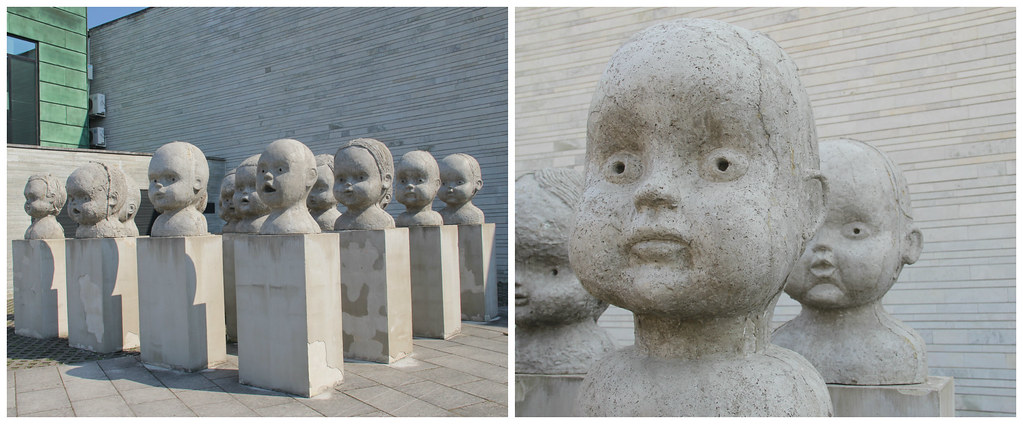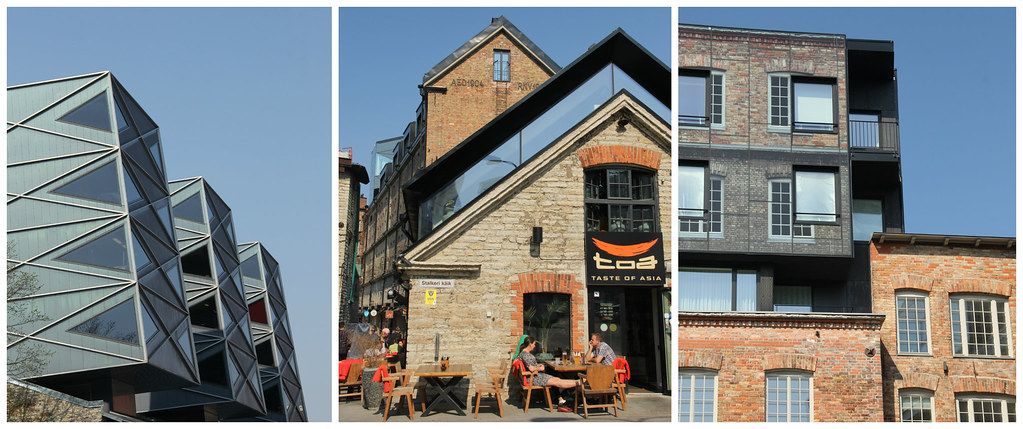There is much more to Tallinn than its Old Town. Find out about all the neighbourhoods that you should be exploring for an alternative Tallinn experience, in this post.
Some of the links in this post are affiliate links. All this means is that if you make a purchase through one of the links I have provided, I will earn a small commission as a result but the cost to you will remain exactly the same.
If you’ve only got two days in Tallinn, it’s all too easy to stay within the safe confines of the old city walls. Tallinn’s Old Town is, after all, ridiculously pretty. There are photo opportunities everywhere you look, hidden alleyways, courtyards and viewpoints to discover, towers to climb, shops to browse, museums to visit and a surprising number of quality restaurants to eat at.
There’s no real need to leave.
Except that if you don’t you’ll be missing out on some amazing alternative parts of the city – one of the largest art museums in Northern Europe, “the most outstanding urban park in Estonia” (Visit Estonia), the largest creative centre in Estonia, some of the best preserved wooden buildings in Tallinn, and a former industrial wasteland that’s been transformed beyond recognition and now houses some award-winning avant-garde architecture.
Beyond Tallinn’s Old Town (but within easy walking distance) you’ll find the neighbourhoods of Kalamaja, Kadriorg and Rotermanni.
And the good news is that it’s completely possible to explore them all, whilst still having a thorough look around the Old Town – all in the space of a couple of days.
Read on for more details about alternative Tallinn, beyond the Old Town.
Alternative Tallinn
1 | Kalamaja / Telliskivi
Kalamaja is quickly becoming one of Tallinn’s trendiest neighbourhoods, but it’s also one of the city’s oldest urban areas.
Back in the middle ages this is where you’d find Tallinn’s primary fishing harbour, and as a result the district was primarily inhabited by fishermen and sailors – a fact that earned the neighbourhood its name; Kalamaja simply means “fish house.”
Between the 17th and 19th centuries, many of the city’s strategically important defensive buildings were located here, and then later on – towards the end of the 19th century – Kalamaja saw rapid industrial growth when the city became connected to St. Petersburg by railroad. This in turn brought about a need for some houses to accommodate the factory workers.
The new two or three-storey dwellings – known as “Tallinn houses” – were built entirely from wood, and are one of the most iconic sights in Kalamaja. Around 500 exist today, dating from the late 19th and early 20th centuries.
To view some of the most magnificent of Kalamaja’s remaining “Tallinn houses,” head to the following streets:
- Salme
- Kungla
- Valgevase
- Kalevi
- Uus-Kalamaja
However, the star of the show for a lot of people visiting Kalamaja is Telliskivi Creative City. A former Kalmin factory turned industrial wasteland has now been transformed into a buzzing arts and cultural hub on the outskirts of Tallinn’s Old Town.
In 2009, the creators of Telliskivi Creative City told a journalist:
“We’re building a self-sufficient city. One made of people who, while different, share a vision of what a friendly, open, and creative community should be like. Not just in these 10 buildings, but across the country.”
From having just one tenant in 2009, the city has expanded to encompass 250 companies, employing approximately 1500 members of staff. You’ll find art galleries and studios, indie shops, quirky cafes, hipster coffee shops and trendy restaurants. There is also a calendar of around 600 concerts and other cultural events each year.
If you’re into street art, you’ll find some pretty cool pieces here, too.
There are some fantastic places to eat over here in this part of alternative Tallinn, and if you’re travelling with friends (I was alone, so it wasn’t such an appealing idea), it’s one of THE places to come for some of the best nightlife in the city.
Try F-Hoone for some quality, reasonably priced food served in an old locomotive plant, Tops retro pub to play some of your favourite tunes on vinyl, Pudel Baar for some of the world’s rarest beers, or if wine is more your thing, head to Svips.
Kalamaja is located on the opposite side of the railway tracks to Tallinn’s Old Town. Head out of the Old Town in a northwesterly direction, along Nunne or Suurtükito and you should soon find yourself confronted with views like these.
Kadriorg
For this part of alternative Tallinn you’ll need to head east. Kadriorg is a quiet leafy area within easy walking distance (around two kilometres) of Tallinn’s Old Town. If you’re not up to the walk, you can also hop on the number 1 tram which heads in this direction.
After conquering the Baltics in the early 1700s, Russian tsar Peter the Great established an estate and public park on this spot, which he named after his wife, Catherine the First. “Kadriorg” means “Catherine’s Valley” in Estonian.
Although you’ll also find many ornate wooden mansions in this area (reflecting the fact that this is Tallinn’s most upscale residential neighbourhood), the park is still the neighbourhood’s main draw, which is why you’ll find a lot of Kadriorg’s attractions located within this vast expanse of greenery dotted with tall trees, ponds and fountains.
The following attractions are located within Kadriorg Park:
- Kadriorg Palace. A baroque palace that was once the residence of Russian Emperors. The gardens here are lovely but it’s the interior that really steals the show.
- Peter the Great House Museum. Peter the Great used this building as his residence on his visits to Tallinn, before the completion of Kadriorg Palace. It’s stocked with items that used to belong to the Russian tsar and his wife.
- Kadriorg Art Museum. The only museum in Estonia dedicated to foreign art. It’s located inside Kadriorg Palace.
- Miiamilla Children’s Museum. Offers fun, creative, and educational activities for 3-11 year-olds. There are lots of hands-on exhibits based around the idea of friendship.
- Russalka Memorial. Constructed in 1902 by Amandus Adamson, in memory of those who lost their lives at the Gulf of Finland on the Russian navy vessel called Russalka.
My favourite attraction though was the incredible KUMU Art Museum, opened in 2006. This modern architectural masterpiece has been built into the side of a limestone cliff and is Estonia’s largest and most cutting edge art museum.
It displays Estonian-created works from the 18th through to the 21st century, and there’s also a huge section dedicated to Soviet-era fashion.
Good to know: KUMU is open Tues-Sun from 10:00-18:00 hours. Admission is €8.
There are also some great places to eat in the area. NOP is a fantastic spot for breakfast or brunch. They focus on local organic produce, some of which they also sell in their attached shop. You’ll also find newly-opened Mantel & Korsten housed in a green wooden building close to the park. It’s the third restaurant owned by Zaštšerinski family; the other two are Moon and Kolm Sibulat (both located in Telliskivi). If it’s a good cup of coffee you’re after, try Gourmet Coffee – also just steps from the park’s entrance.
Rotermanni
Just as close to the Old Town as Telliskivi in Kalamaja, but in the opposite direction, Rotermanni is located at the mid-way point between Viru Square, the Old Town and the city’s port.
The area is named after Christian Abraham Rotermann (father to one of the most notable major industrialists in turn of the century, Christian Barthold Rotermann), who came to Tallinn in 1828 and founded a merchant court here. The merchant court primarily dealt with the production, import and export of construction materials. By the beginning of the 20th century the Rotermann business had expanded so extensively that a whole complex of factories had merged with Rotermann’s merchant court.
However, during the Soviet years the area fell into decline as companies became nationalised, and by 1979 it was nothing more than an industrial wasteland used to film scenes for Andrei Tarkovsky’s allegorical sci-fi movie, ‘Stalker.’
Fortunately though, authorities recognised the historical and cultural value of the buildings in the Rotermann Quarter, and preservation work began in 2001. Among the buildings that have been renovated are a gravel mill, a wheat and rye mill, a test mill, a boiler plant, a power plant, and a boarding house with three techno-futuristic-looking towers. The latter was chosen as one of the finalists for the European Union Architecture Award 2009.
Nowadays it’s a fantastic place to come to witness the amalgamation of historic buildings with modern avant-garde architecture and design. The Rotermann Quarter (or “Rotermanni,” as it’s also known) is a vibrant commercial and cultural centre, featuring offices, apartments, design shops and trendy restaurants.
Taste of Asia serves authentic-tasting Thai food and NOYA mixes Japanese traditions with Scandinavian cuisine. Alternatively you’ll find coffee shop and bakery, RØST housed inside an impressive building that used to be an old flour mill, or if quality craft beers are more your thing then head to BrewDog.
Where to stay in Tallinn
Booking.com is my go-to site for researching and booking accommodation. On the whole I find that they offer the cheapest prices and widest selection of accommodation and their free cancellation options are invaluable when I’m in the process of forming an itinerary for a trip.
You’ll be best placed staying in the Old Town if you want to explore all three neighbourhoods listed in this post. Have a look at accommodation options in Tallinn’s Old Town here.
Alternatively, if you’ve not yet used Airbnb, sign up here and you can get £25 off your first booking.
However, if you’d like a personal recommendation, I chose to stay at Tallinn City Apartments due to their central location (I stayed in the one bedroom apartment at Pikk 40), fantastic customer reviews and great value for money.
And I absolutely loved my choice! The apartment was huge, clean and quiet, and a wonderful, comfortable place to return to at the end of a busy day of sightseeing.
If you like this article, please share it on social media using the share buttons at the top of the post. And if you’d like to save it for reading later, why not pin to one of your Pinterest boards? Alternatively you can follow along on Facebook, Twitter, or Google+ or you can look me up on Instagram or Pinterest too!





























5 Comments
I’m planning a trip to the Baltic countries, so it’s perfect timing to run into your post 🙂 I love to see that there’s more than the typical old city. I’m sure it’ll be beautiful, but it’s great to have more to explore. Amazing tips, thanks so much!
So pleased you found it useful, Coni! And I agree, as beautiful as Tallinn’s Old Town is, it’s always nice to explore an alternative side to the city. And I love that Tallinn is so compact that you can see so much of it without jumping on a single bus or tram 🙂
Thank you so much for sharing the valuable post.
Cheers for this Article! I’ve wanted to visit Estonia for a while and it’s nice to see a focus on some different places in the country. Cheers!
Really pleased you enjoyed it! I love discovering what cities have to offer away from the main tourist spots and I hope that I can encourage others to do the same 🙂